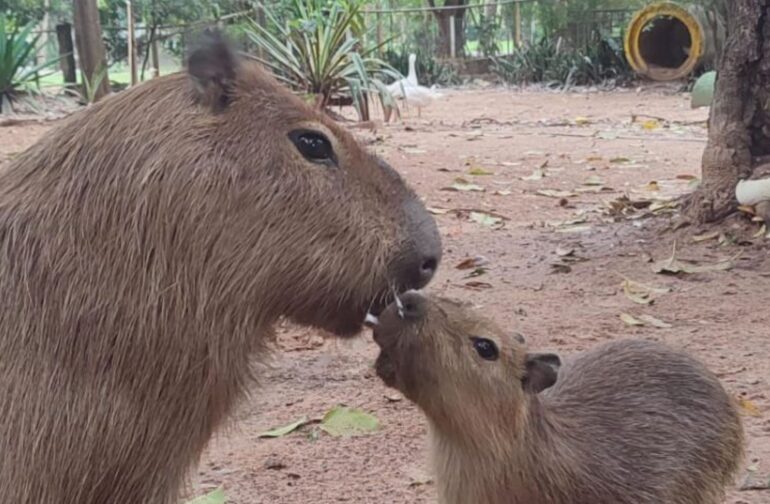The Asunción Zoo has two new capybaras, which were born in January of this year, becoming among the most beloved animals by the hundreds of visitors who come to meet them each day.
By far the most exciting thing to happen at the Zoological Garden of Asunción so far this year, the birth of the two capybaras has seen visitor numbers rocket higher. The two specimens were born on January 21 and, apart from these two new babies, the same mother had had two babies on August 8, 2024, so there are currently four capybara babies in the Zoological Garden.
The capybara – also known as the chigüire, ronsoco, capincho or carpincho, is a species of rodent from the cavid family, native to South America. It is the largest and heaviest living rodent in the world. The other existing member of this genus is the lesser capybara, reported the Municipality of Asunción.

Those that are traditionally known in the country as capybaras, are now being called Capibaras, and are being promoted as part of a children’s program which has these little animals as its main protagonists. These cute over-sized rodents have become the favorites of children, not only in Paraguay, but throughout Latin America and beyond.
They really enjoy the massive affection of children, and it is a way for awareness to be raised about the danger of extinction of this highly persecuted species, which however does not occur in Paraguay, where they reproduce normally in the areas of swamps and waterholes.
The babies are with their parents
Veterinarian Dr. Stella Espínola, head of the Veterinary Department at the Zoological Garden, said that these animals live in herds and reproduce quite well, both in the wild and in captivity.
He said that there are people who breed in captivity and that, precisely, what occurred in the zoo are specimens born in that way.
“These two new specimens, due to the impact of the series on children, are already the main attractions of the zoo, which is already very busy during these holidays and where the majority of the visitors have been for some time, especially in front of the capybara habitat, wanting to meet the new inhabitants of the place,” he explained.
Other attractions at Asunción Zoo
He mentioned the habitats of the big cats as another of the great attractions of the Asunción Zoo, taking into account that many people who come to the place, the first thing they ask about is this site.
“Among them are tigers, pumas and jaguars. There are approximately 30 felines of different species, cared for and fed by the Mari Llorens Foundation. The growth of the species is specifically due to the rescue of specimens from people who contact the foundation, people who find pumas or puma cubs on their property. Then, abandoned, they bring them to the zoo. That is why there are so many pumas,” she explained.

He stressed that the Maris Llorens Foundation is responsible for providing all the food for the felines, which is expensive, since they eat meat with prime cuts, that is, of excellent quality.
He also said, as a curiosity, that the largest animals in the zoo are two hippos, which weigh approximately three tons each, and consume more than 50 kilos of food per day.
“They are mostly herbivores, but we actually also provide them with vegetables, such as pumpkin, squash, fruits like banana, watermelon and other seasonal fruits. They are also given alfalfa and feed,” he said.
How and when to visit Asunción Zoo
He took the opportunity to remind that the Zoo’s visiting hours are from Tuesday to Sunday, from 9am to 4pm, clarifying that on Mondays it is closed for maintenance work and for the animals to rest a little, after having a Sunday of many visits.
“There are a lot of people, especially on weekends, but also on other days because we are still in the school holiday period,” he concluded.


